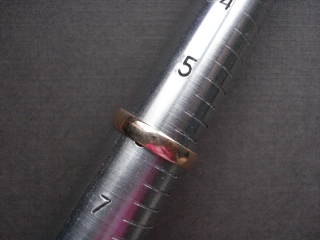7 Ways to Size a Ring
Methods which use existing rings are better because the rings are already known to be a good fit for the fingers. A ring must not only fit comfortably but be just big enough to ease over the second knuckle.
Just to confuse things, be aware that ring sizing nomenclature differs internationally. Remember fingers also tend to be smaller in the morning and swell a bit more later in the day. So it is best to take measurements at the end of the day.
1. String
Take a piece of string and wrap it around the finger. Mark where it overlaps and measure the distance between the markings. This distance is the circumference. This online conversion site saves you from having to do the math to determine the diameter in inches or mm. It also gives 5 other international ring sizing conversions by simply typing in one value.
This is probably the most inaccurate method because the string you use may stretch. As you can see in the picture, the broader marker marks also add to the uncertainty.
2. Ruler or Calipers
Just measure the internal diameter of the ring and read off a ring size chart to get the ring size. Good calipers are much more accurate than rulers. Also check my past post on how to use vernier calipers if you have one.
3. Ring Mandrel
Using the ring mandrel is okay but not that accurate especially if the ring band is broad. Where do you read the size? In this example, the ring is approximately over the size 6 mark. However, the edges of the ring indicate sizes larger and smaller than 6. The best way is to determine the size at approximately the middle of the ring.
4. Ring Gauges
Shown here is a professional quality ring sizer.
5. Cut Out Ring Sizer
There are many different paper ring sizers available for print out on the internet. The idea is to place the paper band around the finger and read off the number. The better ones require making a slit in the paper cut out and then wearing it like cinching in a belt. Here is one example from the Jewelry Mall. They also include a toe ring sizer!
6. Ring Diameter Template
Blue Nile Canada has a great printable template with various diameters of rings to compare with. It's important to follow their instructions to confirm the size of the paper otherwise accuracy goes out the window.
The template comes with actual diameter of rings in mm which can then be cross-referenced with their international ring sizing charts
7. Online Ring Sizer
A really cool online tool is Find My Ring Size. The software includes a way of calibrating your screen so that the round circles are the right size. It's very convenient but care must be taken to pick the right circle and hence the right size. The ring should just enclose the circle on the inside.









No comments:
Post a Comment